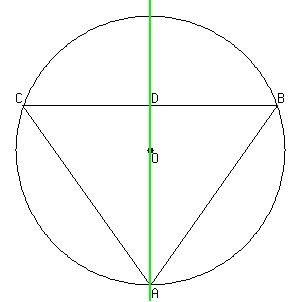Question 636237: Use an inverted cone cut from the sphere (radius of 9cm) to dispense 100ml of a chemical. Chemical needs to be dispensed correct amount of quantity(100ml) and so 100ml increments need to be marked on the outside of cone.
The maximum volume of a cone is  and so the volume of this particular cone will be 904.7787cm^2. and so the volume of this particular cone will be 904.7787cm^2.
I think ratios need to be used to find the distance between the increments but not sure how to do this if its right. Would be much appreciated if you would be able to help. THX.
Answer by KMST(5328)   (Show Source): (Show Source):
You can put this solution on YOUR website! The formula  gives you the maximum volume for a cone cut of a sphere of radius gives you the maximum volume for a cone cut of a sphere of radius  , ,
and for  , we get , we get  . .
The chemical filling up to the markings for 100-mL, 200-mL, 300-mL, and so on,
would be in the shape of similar cones, all scaled down versions of the big cone.
Their volumes (in cubic cm, which are equal to mL) would be directly proportional to the cube of the height in cm.
The function relating height to volume for the chemical would be
 , ,
so if the height of the cone (in cm) is  , ,
we can calculate the heights (in cm) for the markings based on the proportion
 --> -->  --> --> 
That formula would work with heights or slant heights,
because, in similar cones, they would be proportional.
To get actual distances between markings on the outside of the cone,
we need to get the slant height of the cone.
There may be an easier way, but I will show how I calculated heights.
Here is a cross section of the sphere (with center O), and the cone (with its axis in green):
 The radius is The radius is  , and , and  ia a fraction ia a fraction  of the radius. of the radius.
In the right triangle ODB,  --> --> 
allows to calculate 
That is the radius of the base of the cone, squared.
The area of the base of the cone is 
The height of the cone is 
The volume of the cone  , is , is

Using calculus, we can figure out that the function  has a maximum has a maximum
for  , ,
where  , ,
So  as stated in your posted question. as stated in your posted question.
Most importantly, since  , ,
the height of the cone (in cm) is
 . .
The radius of the base of the cone, squared, is

The slant height,  can be calculated based on right triangle can be calculated based on right triangle  . .
 --> -->  = about = about 
Now we can substitute the values for  and and  into into
 , ,
or using the slant height,  , of the cone, , of the cone,

to calculate the height,  , or the distance from the cone vertex, , or the distance from the cone vertex,  for the markings for volumes for the markings for volumes  of 100 mL, 200 mL, and so on. of 100 mL, 200 mL, and so on.
 --> -->  and and
 --> --> 
|
|
|